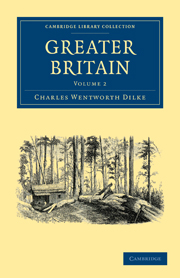Book contents
- Frontmatter
- Contents
- LIST OF ILLUSTRATIONS
- PART III
- PART IV
- CHAP. I MARITIME CEYLON
- CHAP. II KANDY
- CHAP. III MADRAS TO CALCUTTA
- CHAP. IV BENARES
- CHAP. V CASTE
- CHAP. VI MOHAMEDAN CITIES
- CHAP. VII SIMLA
- CHAP. VIII COLONIZATION
- CHAP. IX THE “GAZETTE”
- CHAP. X UMRITSUR
- CHAP. XI LAHORE
- CHAP. XII OUR INDIAN ARMY
- CHAP. XIII RUSSIA
- CHAP. XIV NATIVE STATES
- CHAP. XV SCINDE
- CHAP. XVI OVERLAND EOUTES
- CHAP. XVII BOMBAY
- CHAP. XVIII THE MOHURRUM
- CHAP. XIX ENGLISH LEARNING
- CHAP. XX INDIA
- CHAP. XXI DEPENDENCIES
- CHAP. XXII FRANCE IN THE EAST
- CHAP. XXIII THE ENGLISH
- INDEX
- Plate section
CHAP. XI - LAHORE
Published online by Cambridge University Press: 29 August 2010
- Frontmatter
- Contents
- LIST OF ILLUSTRATIONS
- PART III
- PART IV
- CHAP. I MARITIME CEYLON
- CHAP. II KANDY
- CHAP. III MADRAS TO CALCUTTA
- CHAP. IV BENARES
- CHAP. V CASTE
- CHAP. VI MOHAMEDAN CITIES
- CHAP. VII SIMLA
- CHAP. VIII COLONIZATION
- CHAP. IX THE “GAZETTE”
- CHAP. X UMRITSUR
- CHAP. XI LAHORE
- CHAP. XII OUR INDIAN ARMY
- CHAP. XIII RUSSIA
- CHAP. XIV NATIVE STATES
- CHAP. XV SCINDE
- CHAP. XVI OVERLAND EOUTES
- CHAP. XVII BOMBAY
- CHAP. XVIII THE MOHURRUM
- CHAP. XIX ENGLISH LEARNING
- CHAP. XX INDIA
- CHAP. XXI DEPENDENCIES
- CHAP. XXII FRANCE IN THE EAST
- CHAP. XXIII THE ENGLISH
- INDEX
- Plate section
Summary
Crossing in a railway journey of an hour one of the most fertile districts of the Punjaub, I was struck with the resemblance of the country to South Australia: in each great sweeps of wheat-growing lands, with here and there an acacia or mimosa tree; in each a climate hot, but dry, and not unhealthy—singularly hot here for a tract in the latitude of Vicksburg, near which the Mississippi is sometimes frozen.
Through groves of a yellow-blossomed, sweetscented, weeping acacia, much like laburnum, in which the fortified railway station seems out of place, I reached the tomb-surrounded garden that is called Lahore—a city of pomegranates, oleanders, hollyhocks, and roses. The date-groves of Lahore are beautiful beyond description; especially so the one that hides the Agra Bank.
Lahore matches Umritsur in the purity of its Orientalism, Agra in the strength and grandeur of its walls: but it has no Tank Temple and no Taj; the Great Mosque is commonplace, Runjeet Singh's tomb is tawdry, and the far-famed Shalimar Gardens inferior to those of Pinjore. The strangest, sight of Lahore is its new railway station—a fortress of red brick, one of many which are rising all over: India. The fortification of the railway stations is decidedly the next best step to that of having no forts at all.
The city of Lahore is surrounded by a suburb of great tombs, in which Europeans have in many cases taken up their residence by permission of the owner, the mausoleums being, from the thickness of their walls, as cool as cellars.
- Type
- Chapter
- Information
- Greater Britain , pp. 286 - 290Publisher: Cambridge University PressPrint publication year: 2009First published in: 1868



